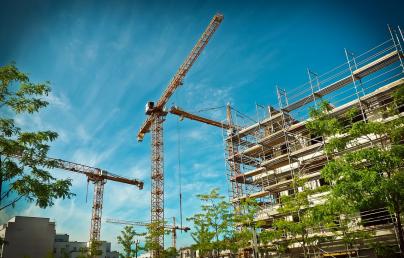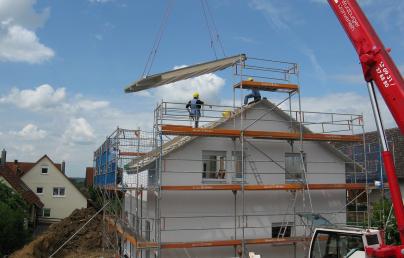Technical Article - Consolidating building data semantics for life cycle assessment

Technical Article - Consolidating building data semantics for life cycle assessment
Antonino Marvuglia (Luxembourg Institute of Science and Technology, Esch-sur-Alzette, Luxembourg)
Sylvain Kubicki (Luxembourg Institute of Science and Technology, Esch-sur-Alzette, Luxembourg)
(Note: opinions in the articles are of the authors only and do not necessarily reflect the opinion of the EU).
Introduction
Accounting for around 40% of the EU's final energy and 36% of CO2 emissions, buildings represent potential substantial unexploited energy-savings (Economidou et al., 2020; Tsemekidi-Tzeiranaki et al., 2019). To ensure sustainable building construction and operation practices, Life Cycle Assessment (LCA) plays a key role in quantifying the impacts of our building stock. Several countries are now considering making an assessment of embodied impacts in buildings a mandatory step to obtain the building permit (Hollberg et al., 2020). This may also be the case for near-future EU practices for issuing Energy Performance Certification (EPC) (Li et al., 2019). Therefore, the impacts of the performance of the use stage of the building are also becoming more relevant. This raises concerns about how to deal with the so-called performance gap, i.e., the discrepancy between the energy demand predicted at the design stage and the actual energy use in the operational phase of the building (Tozan et al., 2022).
The building sector can already rely on several guidance frameworks, like BREEAM, LEED and Level(s), which were designed according to sustainability principles and cover diverse domains (energy, water, materials, human comfort, etc.). The Building Information Modelling (BIM) domain is already integrated with LCA tools and is becoming industry practice. However, BIM is limited in applying LCA, and only covers design stages (i.e., the impacts of materials and construction process). For the building use stage, the Digital Twin (DT) paradigm (Boje et al., 2020; Marvuglia, 2021) can facilitate the collection of complementary data that can be used to monitor and validate the impacts estimated in the LCA conducted at the building design phase. As a result of the lack of a unique paradigm, the data gathered on our buildings is fragmented and hybrid in nature, which poses significant integration and implementation challenges.
Within the SemanticLCA project we tackled several real-world use cases on using BIM and DT in buildings, by integrating data with semantic web technologies to fill the data consolidation gap outlined above. Interestingly enough, this is also in line with the strategic and innovation agenda for smart buildings on data integration methods (part 1) and future LCA avenues (part 6) of the recent report from the SmartBuilt4EU
Estimating, monitoring, and validating building performance
As part of our research, a pilot office building located in the south of Luxembourg is under constant monitoring, with detailed as-built BIM data. Several use cases have been defined whereby an LCA methodology can be used to estimate the impacts of several aspects, most notably:
- Embedded building materials
- Electricity and water usage
- The impact on human health
Providing data for these use cases involves integration of BIM data with data collected by sensors as well as other assumptions, which create a complete context for the LCA foreground inventories definitions. To conduct the analyses and present the results, we have adopted the modular approach by life cycle stage, according to the EN15978 standard for buildings.
Although BIM and DT are virtual representations of buildings and construction sites, they distinguish themselves in both scope and function. Most fundamentally, where BIM is used to design and plan, DT is used to monitor and optimise the use of resources during the operation stages (Boje et al., 2020). We consider BIM and DT as complementary technological and procedural concepts. Both have different relevance to each life cycle stage, according to the data they gather and provide. This is illustrated in Figure 1, overlapping with the EN 15878 modules (European Committee for Standardization, 2011).
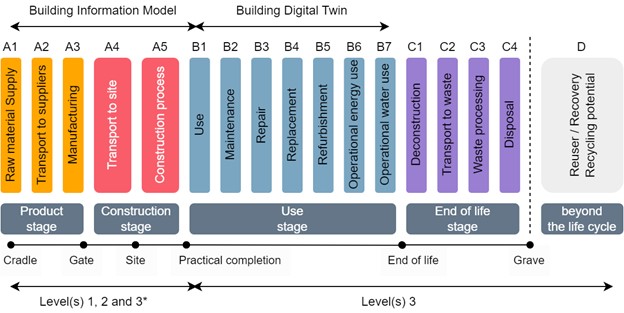
Figure 1. Lifecycle stages of a building according to the EN15978 standard, with indication of the phases where the information coming from BIM and DT is useful, and of Level(s) indicators (see Table 1).
Several data samples are presented below from the Luxembourg pilot building. Figure 2 shows that operational energy use (B6 module) predominates in terms of emissions across the life cycle, with sourced material products coming in second. At design and construction stages, the operational impacts can only be estimated using limited data and the use of a BIM and other design assumptions, which are normally used to issue an Energy Performance Certificate (EPC). The impacts related to the real building performance are unknown until the building is in its use stage. Based on our DT monitored data, the yearly electricity usage (and the consequent CO2-eq emissions) is on average higher than the value predicted in the EPC, as shown in Figure 3. This emphasises the importance of monitoring and validating the estimated impacts using the operational stage consumption measurements.
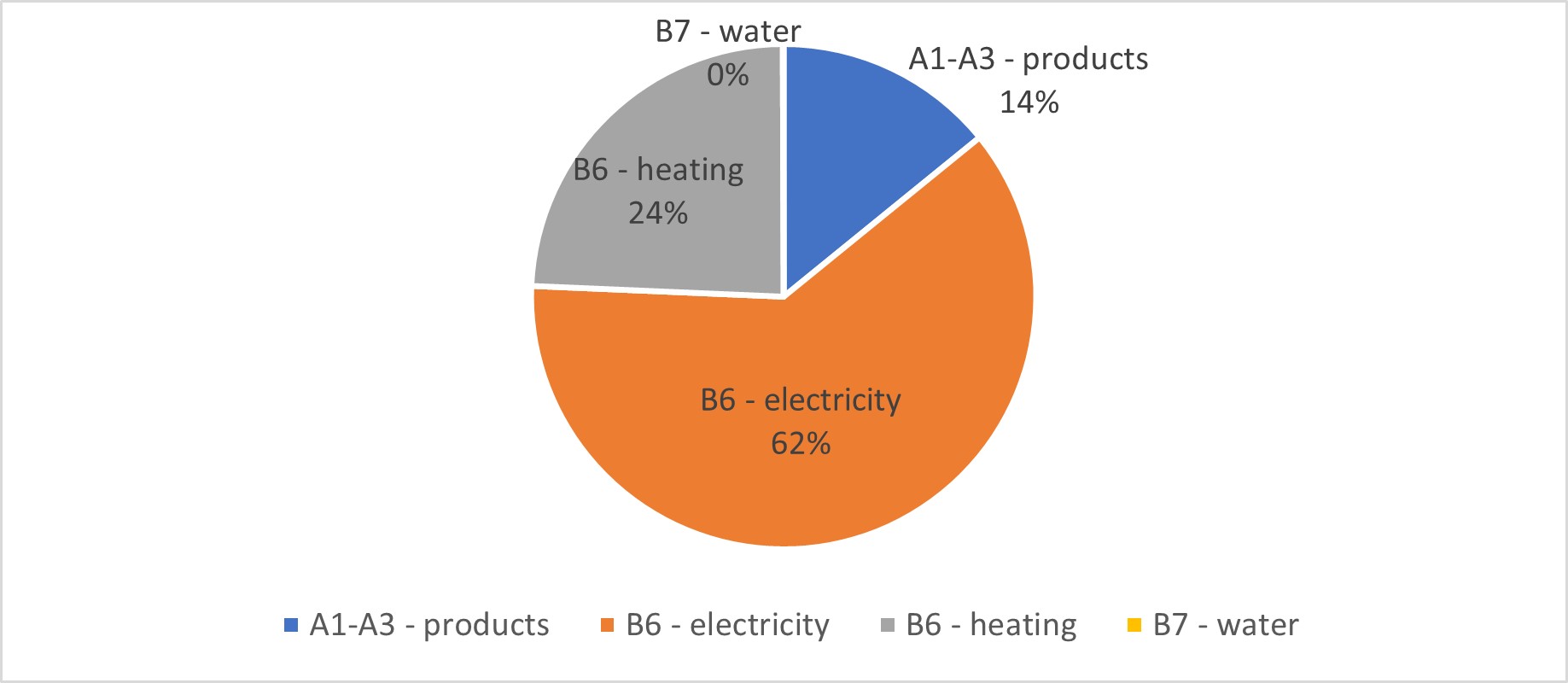
Figure 2. Measure CO2-eq emissions of the Luxembourgish pilot building for several life cycle modules according to EN 15978, based on BIM sourced material data and DT monitored data.
As well as monitoring the background impacts related to the use of the building, attention is also growing on investigating the direct (foreground) impacts generated by buildings on their occupants (Fnais et al., 2022) (Fnais et al. 2022). Frameworks such as Level(s) endorse the use of sensing equipment in buildings for monitoring the indoor air quality (IAQ), but without linking them to LCA-processes being involved, as far as standards for buildings are concerned (such as the EN15978).
Several LCA-based approaches to quantify the negative effects on human health have been applied in different case studies (Collinge et al., 2013; Maury-Micolier et al., 2023), including one that was part of the SemanticLCA project (Hahn Menacho et al., 2023). Figure 4 shows the outline of one floor within the pilot building and indicates the variables measured by our sensing infrastructure, while Figure 5 presents a sample on the concentrations of Total Volatile Organic Compounds (TVOC) and particulate matter below 2.5µm (PM2.5), measured over a sample week within one of the office spaces in the building. In (Hahn Menacho et al., 2023), we combined BIM and DT-sourced data to infer the impacts on human health, evaluating the necessary trade-offs with energy use necessary to ensure a proper ventilation in order to decrease negative impacts on occupants’ health.
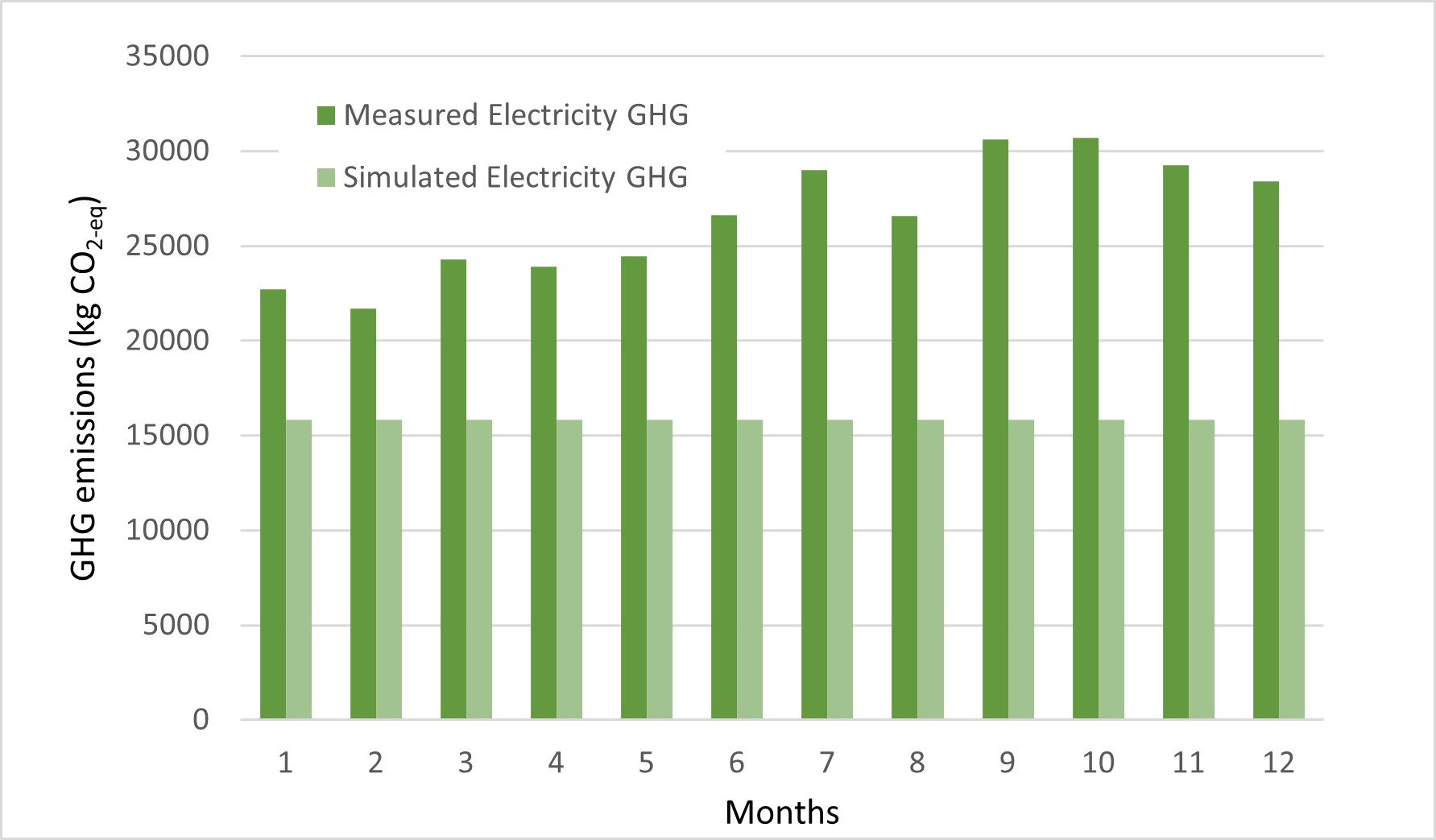
Figure 3. Monthly GHG emissions (in kg of CO2-eq) for electricity use for the Luxembourgish pilot over one year. Values simulated for the EPC vs real measurements.
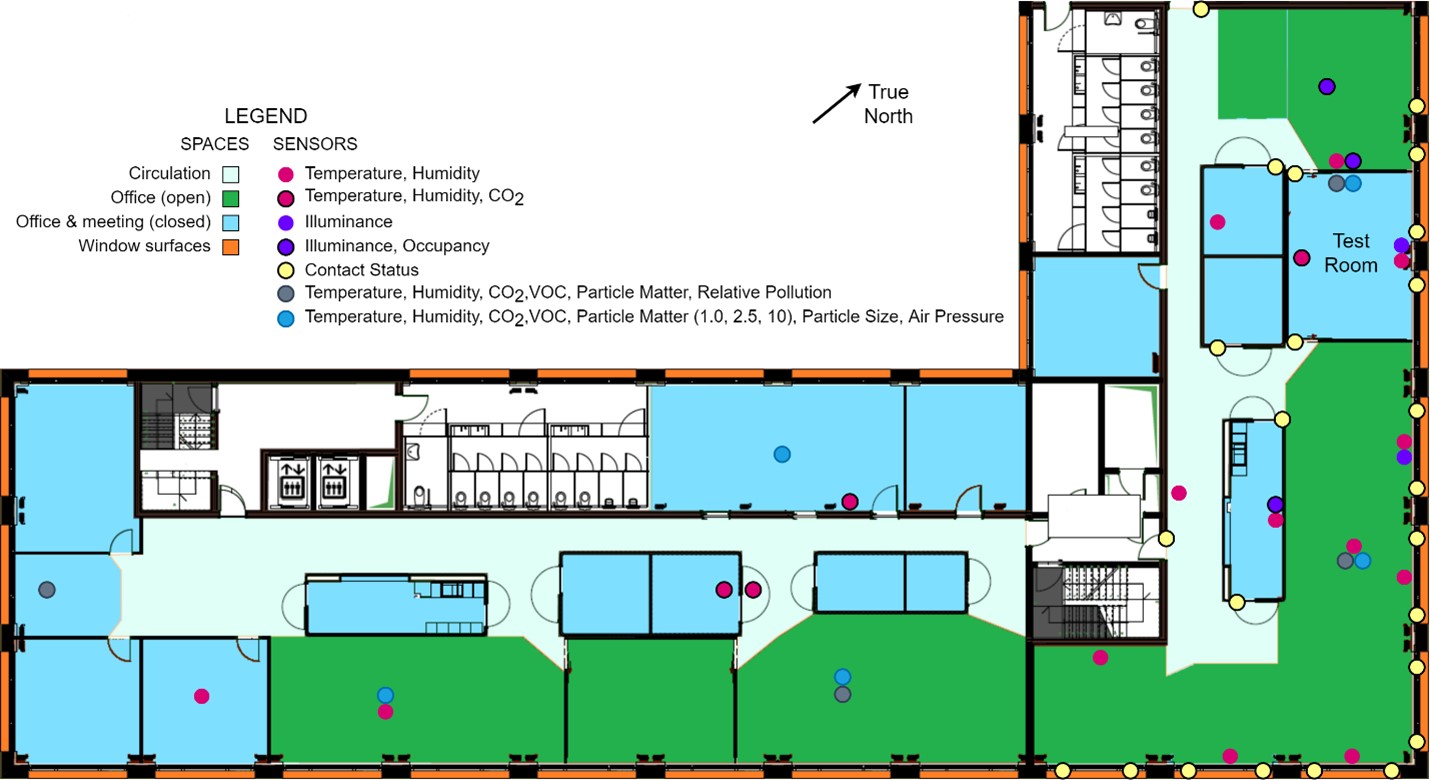
Figure 4. Luxembourgish pilot office building with sensor placement on one floor for IAQ monitoring (Boje et al., 2021), with tested methodology in (Hahn Menacho et al., 2023)
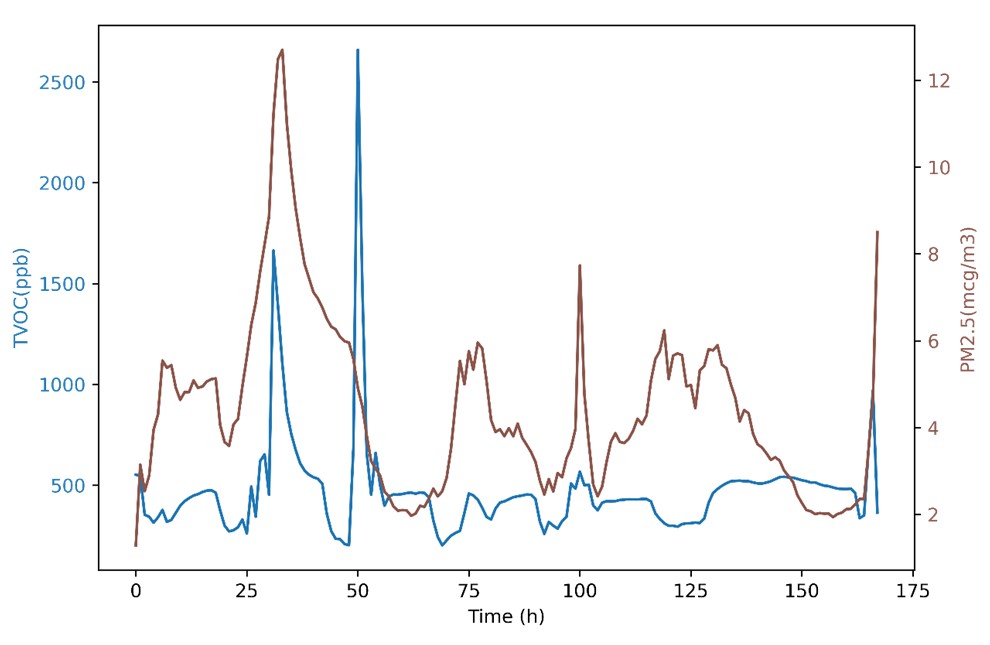
Figure 5. Weekly sample of air pollutants (TVOC) and CO2 concentration within a selected office space in the Luxembourgish pilot building (Boje et al., 2021)
BIM and DT data for LCA
As anticipated above, the dynamic indoor environment presents several challenges on how the data is gathered, processed, and considered for knowledge acquisition across all life cycle stages. We consider BIM-source data as static, whilst DT-sourced data is dynamic. These need to be carefully modelled under explicit semantics. We will further clarify these concepts in the following sections.
BIM – the static data provider
BIM models represent the data repository from design to construction and are already regularly used as a main source of information for design stage LCAs (Obrecht et al., 2020; Zimmermann et al., 2021), and are successfully linked to most LCA construction datasets (Hollberg et al., 2020; Safari and AzariJafari, 2021). Thus, LCA of embedded materials and products within a building are already well understood and accurate, but the validity of the impacts linked to water and energy usage in the operational phase of the buildings, or disposal and recycling of materials after building decommissioning remain highly uncertain.
BIM object properties are used to compute air flows and volumes of air exchanges between spaces for IAQ calculations (Boje et al., 2021), which is complementary to conventional LCA procedures. Thus, BIM is a good source of semantic building data, but quickly loses relevance once the building passes to its use stage.
DT – the dynamic data provider
We consider the building DT to better handle the later use stage of the building life cycle, and to be able to deal with the innate building dynamics for energy use and IAQ. The aspects of the building use that depend on human behaviour (such as building’s occupancy or equipment operation) are not predictable at early design stages, which can cause uncertainty on LCA results and generate the above-mentioned performance gap (Zou and Alam, 2020). Whilst data can be monitored daily, it needs to be interpreted and transformed for higher tier processing, such as the application of machine learning based techniques or optimisation algorithms (Hahn Menacho et al., 2023). Transformation and interpretation of such data relies on complex DT systems, a topic still under development (Fuller et al., 2020), facing several challenges in integrating and consolidating the data.
The complementarity for BIM and DT
BIM and DT are complementary data providers required to close the performance gap between design and use. The fact that both the BIM and the DT can represent a building virtually can generate confusion, but they are distinguishable in both scope and function. The BIM is used primarily in design and construction for a more efficient building process; it is a reference for estimating the building performance and behaviour. The DT is used to monitor, optimise, and allocate resources (energy, water, etc.) in a smarter way across the building operation stage. It can also play an important role to monitor the occupant’s environment.
The newer European framework for sustainable buildings, Level(s), harmonises the core indicators for more suitable buildings. These indicators primarily look at environmental performance (via LCA), health and comfort for occupants, life cycle costs and added values, as well as the potential risks and future performances. This encourages various methodologies and standards (such as LCA) to better estimate and manage material resources, emissions, human comfort, etc. With sustainability as the end-goal, we correlate BIM and DT sourced data with Level(s) data requirements (Figure 1). If we look at how Level(s) is designed, we consider BIM involved at design at every level (1,2 and 3), but the DT plays a role in few selected scopes, such as shown in Table 1, as it is involved directly at level 3.
Table 1. Scopes of BIM and DT within the Level(s) sustainability framework.
Level(s) objective | Scope | BIM role | DT role |
GHG emissions | Building performance | Estimate | Monitor, validate |
Resources use | Building materials | Estimate, monitor, validate | Validate (at renovation) |
Water use | Water usage | Estimate | Monitor, validate |
Health and comfort | Indoor air quality | n/a | Monitor, validate |
Although BIM and LCA integration has improved, it still faces many challenges such as poor data quality and fragmentation (Zimmermann et al., 2021) hindering automation pipelines and making backtracking on results interpretation cumbersome. DT systems face similar problems on creating correct indoor environment contexts, which need to be based on higher level semantics to provide real value to LCA pipelines.
Semantics for consolidating LCA-related building data
The SemanticLCA project tackles data integration limitations by adopting semantic web technologies on its pilot buildings (in Luxembourg and the UK), trying to integrate the hybrid data sources for more streamlined LCA data pipelines.
Semantic web ontologies
Building semantics within the construction industries rely on standards such as the Industry Foundations Classes (IFC) under ISO 16739-1:2018, which was initially designed as an information exchange format. As the application domains around buildings quickly expanded, the use of semantic web ontologies has become widely used (Pauwels et al., 2018), with several new specialised ontology data schemes available to represent and integrate building data with resources on the web. BIM-related ontologies and schemes of relevance to LCA use are listed in Table 2.
The challenge in developing DT lies in managing and connecting the dots of all the components discussed above. We can see that the BIM domain dominates the building representation. The central ontology at this stage is considered the IFC schema. However, its size and scope will dwarf most specialised applications, and slow down a knowledge store. Several more light-weight and specialised ontologies which aim at representing BIM assets are available, ranging from geometric representations (e.g., BOT) and management (e.g., FOG), to properties management (e.g., OMG), etc. To accommodate the sensor network representation for the DT monitoring and actuation capabilities, ontologies such as SAREF4Building or SSN/SOSA are used. These data models need to be linked to LCA concepts and their specific use-cases (as we have described in section 1). In this sense, ontologies such as Bonsai (see Table 2) are used to represent LCA activities, flows and their properties, which can be mapped to existing LCA databases.
Existing ontologies and schemas
The SemanticLCA project adopted a standard ontology engineering approach, building a new ontology from scratch on specific case studies around the built environment, building on several existing ontologies.
Table 2. Relevant ontologies combining BIM and DT with LCA application.
Ontology/Schema | Domain | Scope |
LCA | Generic | |
LCA | Generic | |
LCA | Generic | |
BIM | Buildings | |
BIM | Buildings | |
BIM | Products | |
BIM | Buildings | |
BIM | Products | |
BIM | Products | |
DT | Generic | |
DT | Buildings | |
|
CONCLUSIONS
LCA plays an important role in quantifying the impacts of our buildings across their entire life cycle. To reduce the performance gap between the impacts estimated at the building design phase and the actual impacts at later building use stages, hybrid sources of data need to be used. Where BIM plays an important role in providing building data about materials and the building geometry from design to construction, the DT plays a complementary role for monitoring the indoor environment and resources used across the use stage. The current research challenge lies in identifying the relevant data sources and consolidating this into complete LCA inventories. Within the SemanticLCA project we tackled this problem using semantic web technologies, attempting to bridge multi-domain data modes for data integration and consolidation. Interesting results have been already achieved in the project at building level, which set a promising foundation to extend the methodology at the district and city level.
REFERENCES
Boje, C., Guerriero, A., Kubicki, S., Rezgui, Y., 2020. Towards a semantic Construction Digital Twin: Directions for future research. Autom. Constr. 114, 103179. https://doi.org/10.1016/j.autcon.2020.103179
Boje, C., Marvuglia, A., Hahn Menacho, Á.J., Kubicki, S., Guerriero, A., Navarrete Gutiérrez, T., Benetto, E., 2021. A pilot using a Building Digital Twin for LCA-based human health monitoring, in: Proc. of the {Conference} {CIB} {W78}. pp. 11–15.
Collinge, W., Landis, A.E., Jones, A.K., Schaefer, L.A., Bilec, M.M., 2013. Indoor environmental quality in a dynamic life cycle assessment framework for whole buildings: Focus on human health chemical impacts. Build. Environ. 62, 182–190. https://doi.org/10.1016/J.BUILDENV.2013.01.015
Economidou, M., Todeschi, V., Bertoldi, P., D’Agostino, D., Zangheri, P., Castellazzi, L., 2020. Review of 50 years of EU energy efficiency policies for buildings. Energy Build. 225, 110322. https://doi.org/https://doi.org/10.1016/j.enbuild.2020.110322
European Committee for Standardization, 2011. EN 15978:2011 Sustainability of Construction Works – Assessment of Environmental Performance of Buildings – Calculation Method.
Fnais, A., Rezgui, Y., Petri, I., Beach, T., Yeung, J., Ghoroghi, A., Kubicki, S., 2022. The application of life cycle assessment in buildings: challenges, and directions for future research. Int. J. Life Cycle Assess. 2022 275 27, 627–654. https://doi.org/10.1007/S11367-022-02058-5
Fuller, A., Fan, Z., Day, C., Barlow, C., 2020. Digital Twin: Enabling Technologies, Challenges and Open Research. IEEE Access 8, 108952–108971. https://doi.org/10.1109/ACCESS.2020.2998358
Hahn Menacho, Á.J., Marvuglia, A., Benetto, E., 2023. Occupant’s health and energy use in an office building: A sensor-enabled life cycle assessment. Build. Environ. 236, 110274. https://doi.org/10.1016/J.BUILDENV.2023.110274
Hollberg, A., Genova, G., Habert, G., 2020. Evaluation of BIM-based LCA results for building design. Autom. Constr. 109, 102972. https://doi.org/10.1016/j.autcon.2019.102972
Li, Y., Kubicki, S., Guerriero, A., Rezgui, Y., 2019. Review of building energy performance certification schemes towards future improvement. Renew. Sustain. Energy Rev. 113, 109244. https://doi.org/https://doi.org/10.1016/j.rser.2019.109244
Marvuglia, A., 2021. Chapter 4. Digital Twin: Enhanced simulation for smart cities, in: Scale Jumping: Regenerative Systems Thinking within the Built Environment. A Guidebook for Regenerative Implementation: Interactions, Tools, Platforms, Metrics, Practice. COST Action CA16114 RESTORE, Working Group Five: Scale Jumping, printed by Eurac Research (Bolzano, IT), pp. 220–223.
Maury-Micolier, A., Huang, L., Taillandier, F., Sonnemann, G., Jolliet, O., 2023. A life cycle approach to indoor air quality in designing sustainable buildings: Human health impacts of three inner and outer insulations. Build. Environ. 230. https://doi.org/10.1016/j.buildenv.2023.109994
Obrecht, T.P., Röck, M., Hoxha, E., Passer, A., 2020. BIM and LCA Integration: A Systematic Literature Review. Sustain. 2020, Vol. 12, Page 5534 12, 5534. https://doi.org/10.3390/SU12145534
Pauwels, P., Poveda-Villalón, M., Sicilia, Á., Euzenat, J., 2018. Semantic technologies and interoperability in the built environment. Semant. Web 9, 731–734. https://doi.org/10.3233/SW-180321
Safari, K., AzariJafari, H., 2021. Challenges and opportunities for integrating BIM and LCA: Methodological choices and framework development. Sustain. Cities Soc. 67, 102728. https://doi.org/10.1016/J.SCS.2021.102728
Tozan, B., Birgisdottir, H., Steinmann, J., Le Den, X., Horup, L.H., Sørensen, A., Röck, M., 2022. Towards EU embodied carbon benchmarks for buildings–Bridging the performance gap: A benchmarking framework. https://doi.org/10.5281/zenodo.6120874
Tsemekidi-Tzeiranaki, N., Labanca, B., Cuniberti, B., Toleikyte, A., Zangheri, P., Bertoldi, P., 2019. Analysis of the Annual Reports 2018 under the Energy Efficiency Directive–Summary report 2019 Luxembourg.
Zimmermann, R.K., Bruhn, S., Birgisdóttir, H., 2021. BIM-Based Life Cycle Assessment of Buildings—An Investigation of Industry Practice and Needs. Sustainability. https://doi.org/10.3390/su13105455
Zou, P.X.W., Alam, M., 2020. Closing the building energy performance gap through component level analysis and stakeholder collaborations. Energy Build. 224, 110276. https://doi.org/https://doi.org/10.1016/j.enbuild.2020.110276
-

